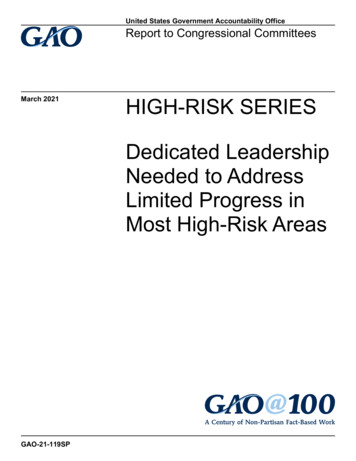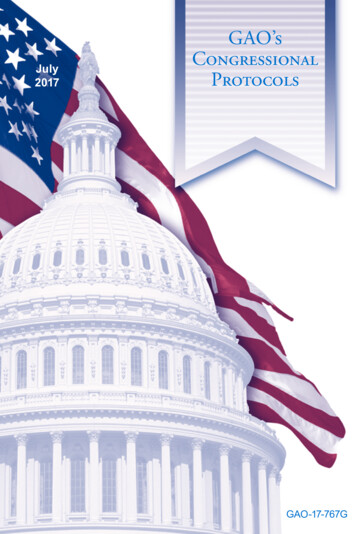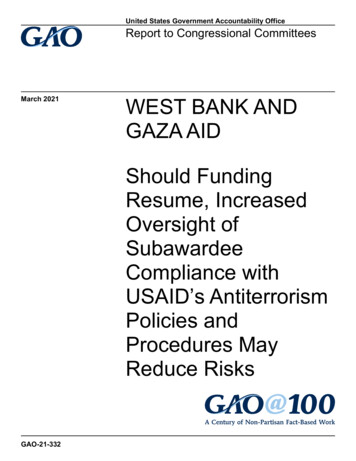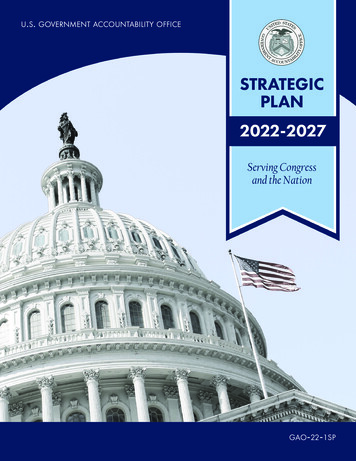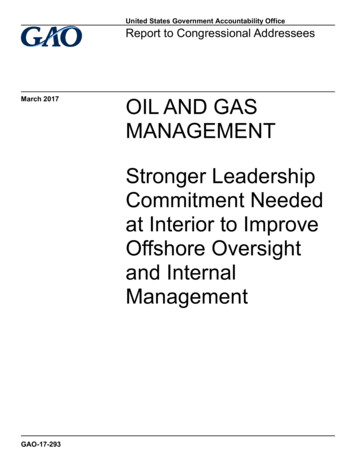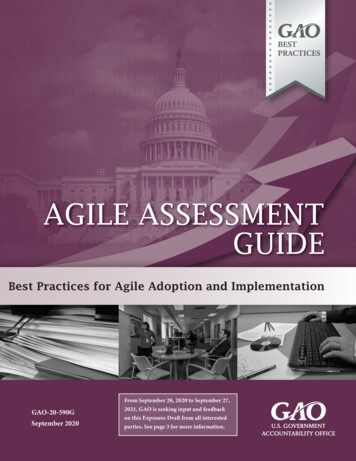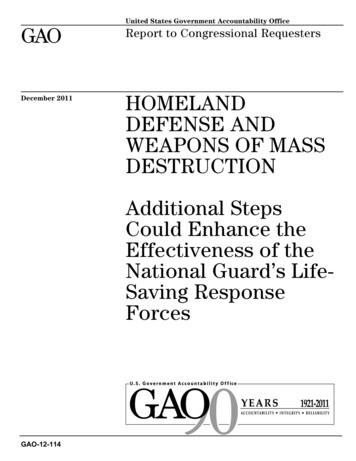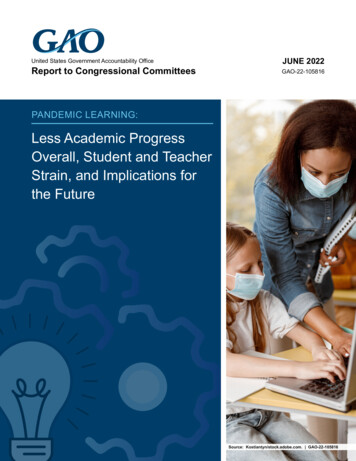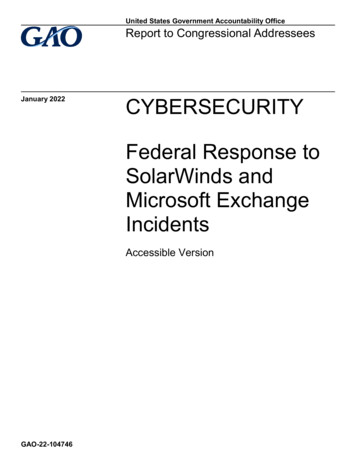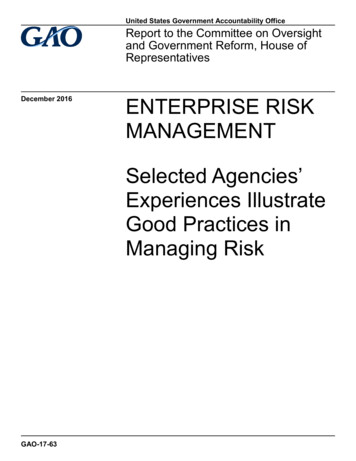
Transcription
United States Government Accountability OfficeReport to the Committee on Oversightand Government Reform, House ofRepresentativesDecember 2016ENTERPRISE RISKMANAGEMENTSelected Agencies’Experiences IllustrateGood Practices inManaging RiskGAO-17-63
December 2016ENTERPRISE RISK MANAGEMENTSelected Agencies’ Experiences Illustrate GoodPractices in Managing RiskHighlights of GAO-17-63, a report to theCommittee on Oversight and GovernmentReform, House of RepresentativesWhy GAO Did This StudyWhat GAO FoundFederal leaders are responsible formanaging complex and risky missions.ERM is a way to assist agencies withmanaging risk across the organization.In July 2016, the Office ofManagement and Budget (OMB)issued an updated circular requiringfederal agencies to implement ERM toensure federal managers areeffectively managing risks that couldaffect the achievement of agencystrategic objectives.Enterprise Risk Management (ERM) is a forward-looking management approachthat allows agencies to assess threats and opportunities that could affect theachievement of its goals. While there are a number of different frameworks forERM, the figure below lists essential elements for an agency to carry out ERMeffectively. GAO reviewed its risk management framework and incorporatedchanges to better address recent and emerging federal experience with ERMand identify the essential elements of ERM as shown below.GAO’s objectives were to (1) update itsrisk management framework to morefully include evolving requirements andessential elements for federalenterprise risk management, and (2)identify good practices that selectedagencies have taken that illustratethose essential elements.GAO reviewed literature to identifygood ERM practices that generallyaligned with the essential elementsand validated these with subject matterspecialists.GAO also interviewed officialsrepresenting the 24 Chief FinancialOfficer (CFO) Act agencies about ERMactivities and reviewed documentationwhere available to corroborate officials’statements. GAO studied agencies’practices using ERM and selectedexamples that best illustrated theessential elements and good practicesof ERM.GAO provided a draft of this report toOMB and the 24 CFO Act agencies forreview and comment. OMB generallyagreed with the report. Of the CFO actagencies, 12 provided technicalcomments, which GAO included asappropriate; the others did not provideany comments.View GAO-17-63. For more information,contact J. Christopher Mihm at (202) 512-6806or mihmj@gao.govGAO has identified six good practices to use when implementing ERM.Essential Elements and Good Practices of Enterprise Risk Management (ERM)ElementsGood PracticesLeaders Guide and Sustain ERM StrategyAlign ERM process Implementing ERM requires the full engagement and commitment of seniorto goals andleaders, supports the role of leadership in the agency goal setting process,objectivesand demonstrates to agency staff the importance of ERM.Develop a Risk-Informed Culture to Ensure All Employees CanEffectively Raise RisksDeveloping an organizational culture to encourage employees to identify andIdentify Risksdiscuss risks openly is critical to ERM success.Integrate ERM Capability to Support Strategic Planning andOrganizational Performance ManagementIntegrating the prioritized risk assessment into strategic planning andorganizational performance management processes helps improveAssess Risksbudgeting, operational, or resource allocation planning.Establish a Customized ERM Program Integrated into Existing AgencyProcessesCustomizing ERM helps agency leaders regularly consider risk and selectSelect Riskthe most appropriate risk response that fits the particular structure andResponseculture of an agency.Continuously Manage RisksConducting the ERM review cycle on a regular basis and monitoring theselected risk response with performance indicators allows the agency totrack results and impact on the mission, and whether the risk response isMonitor Riskssuccessful or requires additional actions.Share Information with Internal and External Stakeholders to Identifyand Communicate RisksSharing risk information and incorporating feedback from internal andexternal stakeholders can help organizations identify and better manageCommunicate and risks, as well as increase transparency and accountability to Congress andReport on Riskstaxpayers.Source: GAO. GAO-17-63United States Government Accountability Office
ContentsLetter1BackgroundUpdated ERM Framework Provides Assistance to Agencies asThey Implement ERMEmerging Good Practices Are Being Used at Selected Agenciesto Implement ERMAgency Comments and GAO Responses51243Appendix ISubject Matter Specialists45Appendix IIComments from the Social Security Administration46Appendix IIIComments from the Department of Veterans Affairs47Appendix IVGAO Contact and Staff Acknowledgements497TablesTable 1: Essential Elements and Associated Good Practices ofFederal Government Enterprise Risk Management (ERM)Table 2: Department of Commerce Roles and SelectedResponsibilities for Enterprise Risk Management (ERM)Table 3: Comparison of Department of Commerce (Commerce)and National Institute of Standards and Technology(NIST) Enterprise Risk Management (ERM) ReferenceCards251320FiguresFigure 1: Essential Elements of Federal Government EnterpriseRisk ManagementFigure 2: National Institute of Standards and TechnologyLeadership Risk Appetite Survey ScalePage i818GAO-17-63 Enterprise Risk Management
Figure 3: Transportation Security Administration VulnerabilityManagement ProcessFigure 4: Department of the Treasury Quarterly PerformanceReview TemplatesFigure 5: Example of an Office of Personnel Management (OPM)Dashboard for Preparing the Federal Workforce forRetirement GoalFigure 6. Transportation Security Administration Risk TaxonomyFigure 7: Selected Questions from Commerce’s Enterprise RiskManagement Maturity Assessment Tool (EMAT)Figure 8: Public and Indian Housing Risk and Mitigation StrategiesDashboardFigure 9: Public and Indian Housing Key Risk IndicatorsDashboardFigure 10: Internal Revenue Service Risk Acceptance Form andTool Decision-Making ToolPage ii2327293334363842GAO-17-63 Enterprise Risk Management
OSOCRODATA InteriorIRSISOITJPSSPage iiiAssociation of Federal Enterprise Risk Managementagency priority goalsAgency Program Management CouncilChief Financial OfficerChief Financial Officers CouncilChief Information OfficerChief Management OfficerDepartment of CommerceChief Operating OfficerCommittee of Sponsoring Organizations of theTreadway CommissionChief Risk OfficerDigital Accountability and Transparency Act of 2014Department of Homeland SecurityDepartment of EducationERM Maturity Assessment ToolEnterprise Risk ManagementExecutive Risk Steering CommitteeFederal Managers’ Financial Integrity ActOffice of Federal Student AidFull-time equivalentGovernment Performance and Results ActGPRA Modernization Act of 2010Department of Housing and Urban DevelopmentDepartment of the InteriorInternal Revenue ServiceInternational Organization for Standardizationinformation technologyJoint Polar Satellite SystemGAO-17-63 Enterprise Risk Management
SATreasuryTSAVANational Institute of Standards and TechnologyNational Aeronautics and Space AdministrationNational Oceanic and Atmospheric AdministrationOffice of the Chief Risk OfficerOffice of Management and BudgetOffice of Program Evaluation and Risk ManagementOffice of Personnel ManagementPerformance Improvement CouncilOffice of Public and Indian HousingPerformance Improvement OfficerPricewaterhouseCoopersquarterly performance reviewRisk Acceptance Form and ToolRisk Management CouncilSocial Security AdministrationDepartment of the TreasuryTransportation Security AdministrationDepartment of Veterans AffairsThis is a work of the U.S. government and is not subject to copyright protection in theUnited States. The published product may be reproduced and distributed in its entiretywithout further permission from GAO. However, because this work may containcopyrighted images or other material, permission from the copyright holder may benecessary if you wish to reproduce this material separately.Page ivGAO-17-63 Enterprise Risk Management
Letter441 G St. N.W.Washington, DC 20548December 1, 2016The Honorable Jason ChaffetzChairmanThe Honorable Elijah E. CummingsRanking MemberCommittee on Oversight and Government ReformHouse of RepresentativesFederal government leaders manage complex and inherently riskymissions across their organizations, such as protecting Americans fromhealth threats, preparing for and responding to natural disasters, buildingand managing safe transportation systems, advancing scientific discoveryand space exploration, maintaining a safe workplace, and addressingsecurity threats. Managing these and other complex challenges, requireseffective leadership and management tools and commitment to deliveringsuccessful outcomes in highly uncertain environments.While it is not possible to eliminate all uncertainties, it is possible to put inplace strategies to better plan for and manage them. Enterprise RiskManagement (ERM) is one tool that can assist federal leaders inanticipating and managing risks, as well as considering how multiple risksin their agency can present even greater challenges and opportunitieswhen examined as a whole. Risk is the effect of uncertainty on objectiveswith the potential for either a negative outcome or a positive outcome oropportunity. The Office of Management and Budget (OMB) defines ERMas an effective agency-wide approach to addressing the full spectrum ofthe organization’s significant internal and external risks by understandingthe combined impact of risks as an interrelated portfolio, rather thanaddressing risks only within silos. An example of an agency enterpriserisk is unfilled mission critical positions across the entire organization thatwhen examined as a whole could threaten the accomplishment of themission.We first issued our risk management framework in 2005 related tohomeland security efforts for assessing threats and taking appropriatesteps to deal with them. 1 At that time, there was no established1GAO, Risk Management: Further Refinements Needed to Assess Risks and PrioritizeProtective Measures at Ports and Critical Infrastructure, GAO-06-91 (Washington, D.C.:Dec. 15, 2005).Page 1GAO-17-63 Enterprise Risk Management
universally agreed upon set of requirements or processes for a riskmanagement framework specifically related to homeland security andcombating terrorism. We developed the 2005 framework with five majorphases that helped us assess how the Department of Homeland Security(DHS) was applying risk management.In July 2016, OMB issued an update to Circular A-123 requiring federalagencies to implement ERM to better ensure their managers areeffectively managing risks that could affect the achievement of agencystrategic objectives. 2 Even before OMB required agencies to adopt ERM,several agencies, after facing significant risks to their mission, wereimplementing ERM to address risk-based issues and improve their abilityto respond to future risks. For example: The Office of Federal Student Aid (FSA) in the Department ofEducation (Education) adopted ERM in 2004, in part, according todocuments we reviewed, to help address long-standing risks includingpoor financial management and internal controls, which led us toplace it on our High-Risk List between 1990 and 2005. 3 The Internal Revenue Service (IRS) adopted an ERM program in2013 to address issues related to the review of tax-exemptapplications cited in a Department of the Treasury (Treasury)Inspector General for Tax Administration report that would improveIRS operations broadly, as well as provide a common framework forcapturing, reporting, and addressing risk areas, and improve thetimeliness of reporting identified risks to the IRS Commissioner, IRSleaders, and external stakeholders, such as Congress. 4 The Office of Public and Indian Housing (PIH) at the Department ofHousing and Urban Development (HUD) finalized its ERM frameworkand implementation plans in 2014. This was done in response toseveral high profile financial and compliance issues with publichousing authorities, as well as concerns over the completeness of its2OMB, Management’s Responsibility for Enterprise Risk Management and InternalControl, Circular No. A-123, (July 15, 2016).3In 2005, FSA was removed from our High-Risk List, not just as a result of adopting ERM,but also through a combination of leadership commitment, capacity to resolve the risk, thedevelopment of a corrective action plan, monitoring of the corrective measures, anddemonstrated progress in resolving the high-risk area.4IRS, Charting a Path Forward: Initial Assessment and Plan of Action (Washington, D.C.:June 24, 2013).Page 2GAO-17-63 Enterprise Risk Management
Federal Managers' Financial Integrity Act (FMFIA) certificationsincluding internal controls and risk management practices, accordingto agency officials. 5We performed our work for this report under the authority of theComptroller General to conduct evaluations to assist Congress with itsoversight responsibilities. Our objectives were to (1) update our riskmanagement framework to more fully include evolving requirements andessential elements for federal ERM, and (2) identify good practices thatselected agencies were taking that illustrate those essential elements. Wealso considered views of subject matter specialists with currentexperience in ERM. See appendix I for the list of subject matterspecialists who advised us in our review of the practices.To adapt our 2005 risk management framework to focus on ERM, weidentified essential elements needed to execute ERM and assist agenciesas they implement and sustain their ERM programs that are generallyconsistent with other commonly used ERM frameworks, such as the ISO31000 Risk Management Principles and Guidelines and the 2004 COSOEnterprise Risk Management - Integrated Framework. 6 When we sharedthese essential elements with subject matter specialists, they confirmedthat they represent the critical elements of the ERM process.To identify good practices in using ERM, we analyzed and synthesizedERM literature using ProQuest, First Search, and Scopus bibliographicdatabases in public and business sources. 7 We validated these goodpractices with subject matter specialists with knowledge specific to theuse of ERM in government settings, and, based on their suggestions, werefined the practices. We then considered the essential elements of ERMrelative to our identified good practices and determined how these531 U.S.C. § 3512.76International Organization for Standardization (ISO), ISO 31000-Risk ManagementPrinciples and Guidelines, (ISO, Nov.15, 2009), and Committee of SponsoringOrganizations of the Treadway Commission (COSO), and COSO, Enterprise RiskManagement-Integrated Framework, 2004. COSO has since updated ERM framework,Enterprise Risk Management-Aligning Strategy with Performance, exposure draft issuedin June 2016, but we did not include this in our analysis.7In the bibliographic database search, we used the following terms, enterprise riskmanagement, best practices, leading practices, government, and public sector, for years2005 through 2015, and searched in scholarly and trade journals, conferenceproceedings, and dissertations and theses.Page 3GAO-17-63 Enterprise Risk Management
practices generally fit with the essential elements as a way to assistagencies as they implemented ERM.To identify what agencies were doing consistent with our essentialelements and how their good practices were used in implementing ERM,we used a semi-structured interview protocol and spoke with officialsrepresenting 21 of the 24 executive branch agencies covered in the ChiefFinancial Officers (CFO) Act of 1990, as amended. 8 Three agencies didnot participate in interviews but provided us with written responses to ourquestions, including the Departments of Agriculture and the Interior andthe Social Security Administration. We asked each of the 24 agencieswhether or not the agency had ERM in place and their perspectives onERM.To identify case illustrations of the good practices, we reviewedinformation from agency interviews and documentation they providedabout their ERM practices. From the ERM practices of 24 CFO Actagencies and their component agencies, we selected examples that bestillustrated our essential elements and good practices. In conducting thecase illustrations, we interviewed agency officials and reviewed agencydocumentation about their use of ERM. We selected examples from nineagencies including the Department of Commerce (Commerce) and itscomponent bureaus the National Institute of Standards and Technology(NIST) and the National Oceanic and Atmospheric Administration(NOAA), DHS’s Transportation Security Administration (TSA), PIH, theOffice of Personnel Management (OPM), Treasury and the IRS, and FSA.We also interviewed OMB officials from the offices involved in the updateof Circular A-123, the Office of Performance and Personnel Managementand the Office of Federal Financial Management, to gain theirperspectives on agencies’ implementation of ERM.We conducted this performance audit from June 2015 to December 2016in accordance with generally accepted government auditing standards.831 U.S.C. § 901(b). The 24 CFO Act agencies, generally the largest federal agencies,are the Departments of Agriculture, Commerce, Defense, Education, Energy, Health andHuman Services, Homeland Security, Housing and Urban Development, the Interior,Justice, Labor, State, Transportation, the Treasury, and Veterans Affairs, as well as theAgency for International Development, Environmental Protection Agency, GeneralServices Administration, National Aeronautics and Space Administration, National ScienceFoundation, Nuclear Regulatory Commission, Office of Personnel Management, SmallBusiness Administration, and Social Security Administration.Page 4GAO-17-63 Enterprise Risk Management
Those standards require that we plan and perform the audit to obtainsufficient, appropriate evidence to provide a reasonable basis for ourfindings and conclusions based on our audit objectives. We believe thatthe evidence obtained provides a reasonable basis for our findings andconclusions based on our audit objectives.BackgroundERM allows management to understand an organization’s portfolio of toprisk exposures, which could affect the organization’s success in meetingits goal. As such, ERM is a decision-making tool that allows leadership toview risks from across an organization’s portfolio of responsibilities. ERMrecognizes how risks interact (i.e., how one risk can magnify or offsetanother risk), and also examines the interaction of risk treatments(actions taken to address a risk), such as acceptance or avoidance. Forexample, treatment of one risk in one part of the organization can createa new risk elsewhere or can affect the effectiveness of the risk treatmentapplied to another risk. ERM is part of overall organizational governanceand accountability functions and encompasses all areas where anorganization is exposed to risk (financial, operational, reporting,compliance, governance, strategic, reputation, etc.).In July 2016, OMB updated its Circular No. A-123 guidance to establishmanagement’s responsibilities for ERM, as well as updates to internalcontrol in accordance with Standards for Internal Control in the FederalGovernment. 9 OMB also updated Circular No. A-11, Preparation,Submission, and Execution of the Budget in 2016 and refers agencies toCircular No. A-123 for implementation requirements for ERM. 10 CircularNo. A-123 guides agencies on how to integrate organizationalperformance and ERM to yield an “enterprise-wide, strategically-alignedportfolio view of organizational challenges that provides better insightabout how to most effectively prioritize resource allocations to ensuresuccessful mission delivery.” The updated requirements in Circulars A123 and A-11 help modernize existing management efforts by requiringagencies to implement an ERM capability coordinated with the strategicplanning and strategic review process established by the GPRAModernization Act of 2010 (GPRAMA), and with the internal controlprocesses required by the FMFIA and in our Standards for Internal9GAO, Standards for Internal Control in the Federal Government, GAO-14-704G(Washington, D.C.: September 2014).10OMB, Circular No. A-11, Preparation, Submission, and Execution of the Budget pt 6,§§270 (July 2016).Page 5GAO-17-63 Enterprise Risk Management
Control in the Federal Government. 11 This integrated governancestructure is designed to improve mission delivery, reduce costs, and focuscorrective actions towards key risks.More specifically, Circular No. A-123 discusses both internal control andERM and how these fit together to manage agency risks. Our Standardsfor Internal Control in the Federal Government describes internal controlas a process put in place by an entity’s oversight body, management, andother personnel that provides reasonable assurance that objectivesrelated to operations, compliance, and reporting will be achieved, andserves as the first line of defense in safeguarding assets. 12 Internalcontrol is also part of ERM and used to manage or reduce risks in anorganization. Prior to implementing ERM, risk management focused ontraditional internal control concepts to managing risk exposures. Beyondtraditional internal controls, ERM promotes risk management byconsidering its effect across the entire organization and how it mayinteract with other identified risks. 13 Additionally, ERM also addressesother topics such as setting strategy, governance, communicating withstakeholders, and measuring performance, and its principles apply at alllevels of the organization and across all functions. 14Implementation of OMB circulars is expected to engage all agencymanagement, beyond the traditional ownership of A-123 by the ChiefFinancial Officer community. According to the A-123 Circular, it requiresleadership from the agency Chief Operating Officer (COO) andPerformance Improvement Officer (PIO) or other senior official withresponsibility for the enterprise, and close collaboration across all agencymission and mission-support functions. 15 The A-123 guidance also11Pub. L. No. 111-352, 124 Stat. 3866 (Jan. 4, 2011).12GAO-14-704G.13For additional discussion about ERM in the federal government, see Dr. Karen Hardy,Enterprise Risk Management, A Guide for Government Professionals, (San Francisco,CA: John Wiley & Sons, Inc., 2015), and Thomas H. Stanton and Douglas W. Webster,Managing Risk and Performance, (Hoboken, NJ: John Wiley & Sons, Inc., 2014).14See COSO, Enterprise Risk Management-Aligning Strategy with Performance, exposuredraft issued in June 2016, for additional information on ERM and its relationship to internalcontrols.15Agencies are required to designate a senior executive within the agency as aPerformance Improvement Officer (PIO), who reports directly to the COO and hasresponsibilities to assist the agency head and COO with performance managementactivities.Page 6GAO-17-63 Enterprise Risk Management
requires agencies to create a risk profile that helps them identify andassess risks arising from mission and mission-support operations, andconsider those risks as part of the annual strategic review process.Circular A-123 requires that agencies’ risk profiles include risks tostrategic, operations, reporting and compliance objectives.A federal interagency group of ERM practitioners developed a Playbookreleased through the Performance Improvement Council (PIC) and theChief Financial Officers Council (CFOC) in July 2016 to provide federalagencies with a resource to support ERM. 16 In particular, the Playbookassists them in implementing the required elements in the updated A-123Circular. 17Updated ERMFramework ProvidesAssistance toAgencies as TheyImplement ERMTo assist agencies in better assessing challenges and opportunities froman enterprise-wide view, we have updated our risk managementframework first published in 2005 to more fully include recent experienceand guidance, as well as specific enterprise-wide elements. 18 Asmentioned previously, our 2005 risk management framework wasdeveloped in the context of risks associated with homeland security andcombating terrorism. However, increased attention to ERM concepts andtheir applicability to all federal agencies and missions led us to revise ourrisk framework to incorporate ERM concepts that can help leaders betteraddress uncertainties in the federal environment, changing and morecomplex operating environments due to technology and other globalfactors, the passage of GPRAMA and its focus on overall performanceimprovement, and stakeholders seeking greater transparency andaccountability. For many similar reasons, the Committee of SponsoringOrganizations of the Treadway Commission (COSO) initiated an effort toupdate its ERM framework for 2016, and the International Organization16U.S. CFO Council and Performance Improvement Council, Playbook: Enterprise RiskManagement for the U.S. Federal Government, (Washington, D.C.: Jul. 29, 2016).17GPRAMA established the Performance Improvement Council (PIC) in law and includedadditional responsibilities. The PIC is charged with assisting OMB to improve theperformance of the federal government. Among its other responsibilities, the PIC is tofacilitate the exchange among agencies of useful performance improvement practices andwork to resolve government-wide or crosscutting performance issues. The Chief FinancialOfficers Council (CFOC) is comprised of federal CFOs, senior officials at OMB, and theU.S. Treasury to address the critical issues in federal financial management withcollaborative leadership18GAO-06-91.Page 7GAO-17-63 Enterprise Risk Management
for Standardization (ISO) plans to update its ERM framework in 2017.Further, as noted, OMB has now incorporated ERM into Circulars A-11and A-123 to help improve overall agency performance.We identified six essential elements to assist federal agencies as theymove forward with ERM implementation. Figure 1 below shows howERM’s essential elements fit together to form a continuing process formanaging enterprise risks. The absence of any one of the elementsbelow would likely result in an agency incompletely identifying andmanaging enterprise risk. For example, if an agency did not monitor risks,then it would have no way to ensure that it had responded to riskssuccessfully. There is no “one right” ERM framework that all organizationsshould adopt. However, agencies should include certain essentialelements in their ERM program.Figure 1: Essential Elements of Federal Government Enterprise Risk ManagementPage 8GAO-17-63 Enterprise Risk Management
Below we describe each essential element in more detail, why it isimportant, and some actions necessary to successfully build an ERMprogram.1. Align the ERM process to agency goals and objectives. Ensurethe ERM process maximizes the achievement of agency mission andresults. Agency leaders examine strategic objectives by regularlyconsidering how uncertainties, both risks and opportunities, couldaffect the agency’s ability to achieve its mission. ERM subject matterspecialists confirmed that this element is critical because the ERMprocess should support the achievement of agency goals andobjectives and provide value for the organization and its stakeholders.By aligning the ERM process to the agency mission, agency leaderscan address risks via an enterprise-wide, strategically-aligned portfoliorather than addressing individual risks within silos. Thus, agencyleaders can make better, more effective decisions when prioritizingrisks and allocating resources to manage risks to mission delivery.While leadership is integral throughout the ERM process, it is anespecially critical component of aligning ERM to agency goals andobjectives because senior leaders have an active role in strategicplanning and accountability for results.2. Identify risks. Assemble a comprehensive list of risks, both threatsand opportunities, that could affect the agency from achieving itsgoals and objectives. This element of ERM systematically identifiesthe sources of risks as they relate to strategic objectives by examininginternal and external factors that could affect their accomplishment. Itis important that risks either can be opportunities for, or threats to,accomplishing strategic objectives. The literature we reviewed, as wellas subject matter specialists, pointed out that identifying risks in anyorganization is challenging for employees, as they may be concernedabout reprisals for highlighting "bad news."Risks to objectives can often be grouped by type or category. Forexample, a number of risks may be grouped together in categoriessuch as strategic, program, operational, reporting, reputational,technological, etc. Categorizing risks can help agency leaders seehow risks relate and to what extent the sources of the risks aresimilar. The risks are linked to relevant strategic objectives anddocumented in a risk register or some other comprehensive formatthat also identifies the relevant source and a risk owner to manage thetreatment of the risk. Comprehensive risk identification is critical evenif the agency does not control the source of the risk. The literature andsubject matter specialists we consulted told us that it is important toPage 9GAO-17-63 Enterprise Risk Management
build a culture where all employees can effectively raise risks. It isalso important for the risk owner to be the person who is mostknowledgeable about the risk, as this person is likely to have the mostinsight about appropriate ways to treat the ris
Enterprise Risk Management (ERM) is a forward-looking management approach that allows agencies to assess threats and opportunities that could affect the achievement of its goals. While there are a number of different frameworks for ERM, the figure below lists essential elements for an agency to carry out ERM
